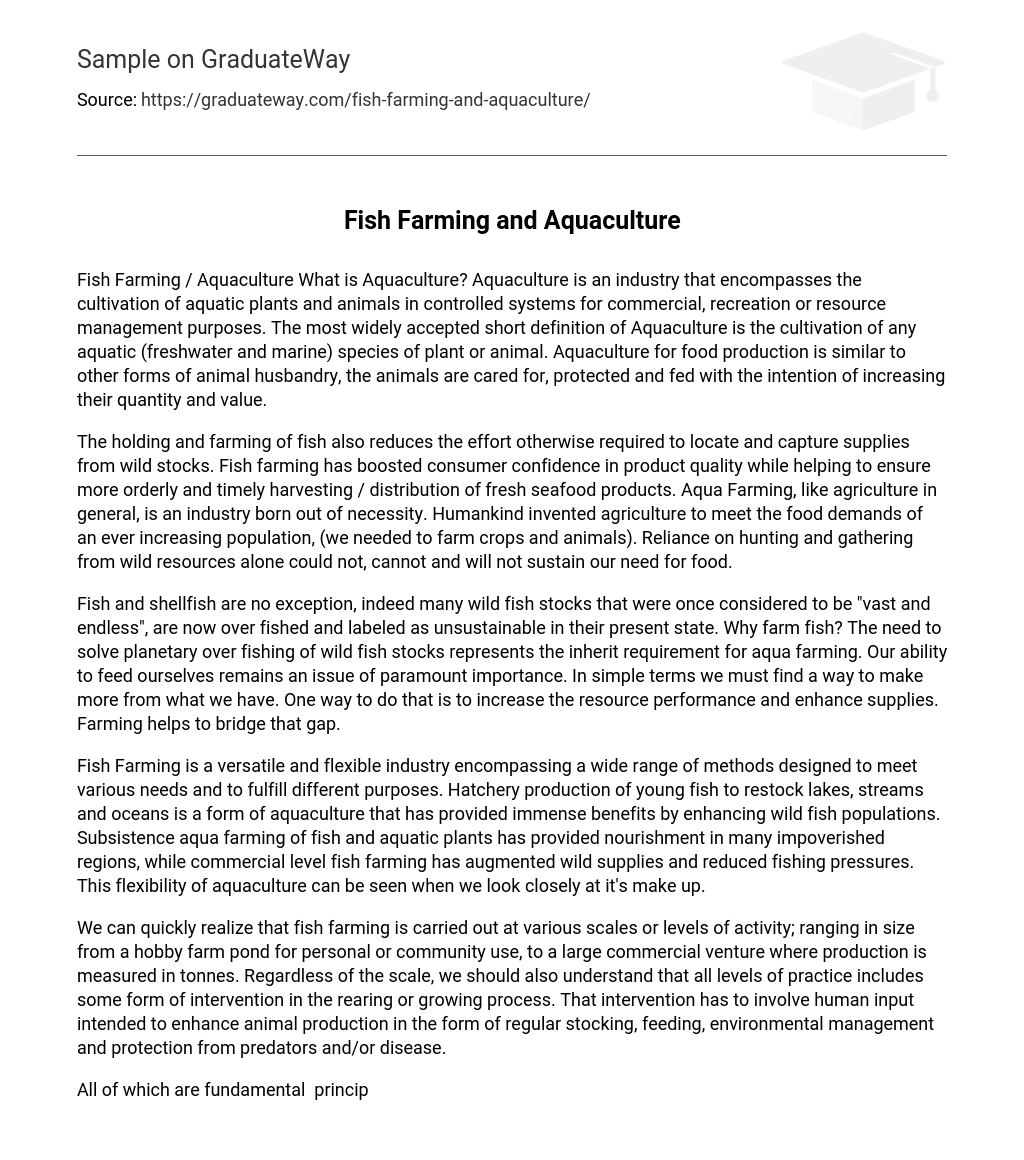Fish Farming / Aquaculture What is Aquaculture? Aquaculture is an industry that encompasses the cultivation of aquatic plants and animals in controlled systems for commercial, recreation or resource management purposes. The most widely accepted short definition of Aquaculture is the cultivation of any aquatic (freshwater and marine) species of plant or animal. Aquaculture for food production is similar to other forms of animal husbandry, the animals are cared for, protected and fed with the intention of increasing their quantity and value.
The holding and farming of fish also reduces the effort otherwise required to locate and capture supplies from wild stocks. Fish farming has boosted consumer confidence in product quality while helping to ensure more orderly and timely harvesting / distribution of fresh seafood products. Aqua Farming, like agriculture in general, is an industry born out of necessity. Humankind invented agriculture to meet the food demands of an ever increasing population, (we needed to farm crops and animals). Reliance on hunting and gathering from wild resources alone could not, cannot and will not sustain our need for food.
Fish and shellfish are no exception, indeed many wild fish stocks that were once considered to be “vast and endless”, are now over fished and labeled as unsustainable in their present state. Why farm fish? The need to solve planetary over fishing of wild fish stocks represents the inherit requirement for aqua farming. Our ability to feed ourselves remains an issue of paramount importance. In simple terms we must find a way to make more from what we have. One way to do that is to increase the resource performance and enhance supplies. Farming helps to bridge that gap.
Fish Farming is a versatile and flexible industry encompassing a wide range of methods designed to meet various needs and to fulfill different purposes. Hatchery production of young fish to restock lakes, streams and oceans is a form of aquaculture that has provided immense benefits by enhancing wild fish populations. Subsistence aqua farming of fish and aquatic plants has provided nourishment in many impoverished regions, while commercial level fish farming has augmented wild supplies and reduced fishing pressures. This flexibility of aquaculture can be seen when we look closely at it’s make up.
We can quickly realize that fish farming is carried out at various scales or levels of activity; ranging in size from a hobby farm pond for personal or community use, to a large commercial venture where production is measured in tonnes. Regardless of the scale, we should also understand that all levels of practice includes some form of intervention in the rearing or growing process. That intervention has to involve human input intended to enhance animal production in the form of regular stocking, feeding, environmental management and protection from predators and/or disease.
All of which are fundamental principals of aqua farming. There are many “wild fish stocks” that are residents of our streams and rivers today, that owe their continual existence to the fundamental practice of aquaculture. The same fundamental practices of enhancing and encouraging existing fish stocks that began ages ago. History of Aquaculture Aquaculture is not a new industry, nor is it an untested concept. The care and farming of fish is rooted in ancient history. The earliest records of fish farming are from Asia (China) where the practice was used often, perhaps as far back as 2500 BC.
This early farming activity involved capturing fish, mainly carps, after river floods and holding them in artificial lakes and ponds. Using a form of polyculture, the fish were fed using the nymphs and byproducts of silkworm farming. This ancient Chinese practice was a simple yet ingenious form of sustainable farming, designed to increase food supplies while diminishing the environmental effects of another farm activity. The value of the animals were increased and accomplished by utilizing by-products that would “today” often be considered waste in much of the western world.
Is it “a wonder” that some 80% of the world’s fish farming activities still take place in Asia? The Bible refers to fish ponds and sluices (Isaiah, Chapter 19, verse 10), and Hieroglyphics illustrate that the Egyptians of the Middle Kingdom (2052-1786 B. C. ) developed ornamental fish ponds and attempted intensive fish culturing. Research indicates that the Roman’s were quite adept in raising fish in ponds and also cultivated oysters. The Hawaiian people practiced aquaculture by constructing fish ponds, an example from ancient Hawaii is a pond at Alekoko dating back at least 1000 years.
It is obvious that aquaculture has an historic and proven background. It was created and developed from the combined works and trials of many civilizations. Yet it’s present contribution to the overall health of our food supplies is often misunderstood. Some of this misunderstanding and confusion may in part be attributed to it’s recent rapid growth combined with a failure to provide meaningful communication of facts, explanations and documentation. In some instances, public perception of it’s true overall value was further clouded by inappropriate decisions made at inappropriate times.





